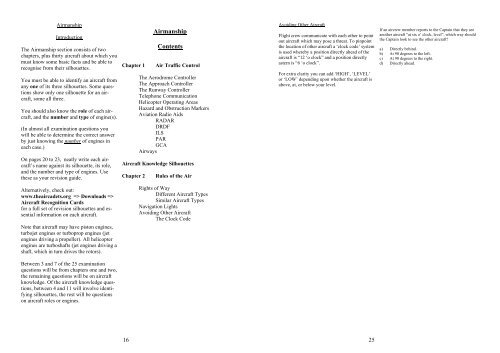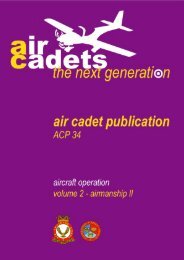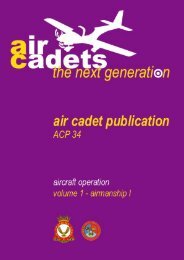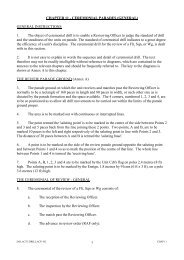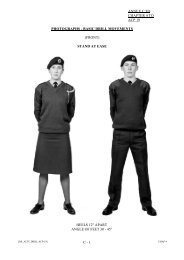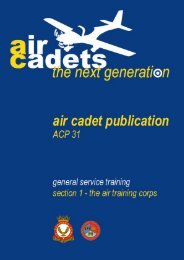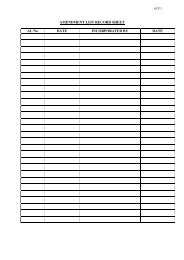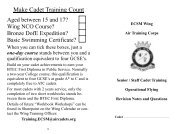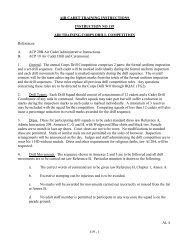Leading Cadet ECSM Wing Revision Guide - 967 Air Cadets
Leading Cadet ECSM Wing Revision Guide - 967 Air Cadets
Leading Cadet ECSM Wing Revision Guide - 967 Air Cadets
You also want an ePaper? Increase the reach of your titles
YUMPU automatically turns print PDFs into web optimized ePapers that Google loves.
<strong>Air</strong>manship<br />
Introduction<br />
The <strong>Air</strong>manship section consists of two<br />
chapters, plus thirty aircraft about which you<br />
must know some basic facts and be able to<br />
recognise from their silhouettes.<br />
You must be able to identify an aircraft from<br />
any one of its three silhouettes. Some questions<br />
show only one silhouette for an aircraft,<br />
some all three.<br />
You should also know the role of each aircraft,<br />
and the number and type of engine(s).<br />
(In almost all examination questions you<br />
will be able to determine the correct answer<br />
by just knowing the number of engines in<br />
each case.)<br />
On pages 20 to 23, neatly write each aircraft’s<br />
name against its silhouette, its role,<br />
and the number and type of engines. Use<br />
these as your revision guide.<br />
Chapter 1<br />
<strong>Air</strong>manship<br />
Contents<br />
<strong>Air</strong> Traffic Control<br />
The Aerodrome Controller<br />
The Approach Controller<br />
The Runway Controller<br />
Telephone Communication<br />
Helicopter Operating Areas<br />
Hazard and Obstruction Markers<br />
Aviation Radio Aids<br />
RADAR<br />
DRDF<br />
ILS<br />
PAR<br />
GCA<br />
<strong>Air</strong>ways<br />
<strong>Air</strong>craft Knowledge Silhouettes<br />
Chapter 2<br />
Rules of the <strong>Air</strong><br />
Avoiding Other <strong>Air</strong>craft<br />
Flight crew communicate with each other to point<br />
out aircraft which may pose a threat. To pinpoint<br />
the location of other aircraft a ‘clock code’ system<br />
is used whereby a position directly ahead of the<br />
aircraft is “12 ‘o clock” and a position directly<br />
astern is “6 ‘o clock”.<br />
For extra clarity you can add ‘HIGH’, ‘LEVEL’<br />
or ‘LOW’ depending upon whether the aircraft is<br />
above, at, or below your level.<br />
If an aircrew member reports to the Captain that they see<br />
another aircraft “at six o’ clock, level”, which way should<br />
the Captain look to see the other aircraft?<br />
a) Directly behind.<br />
b) At 90 degrees to the left.<br />
c) At 90 degrees to the right.<br />
d) Directly ahead.<br />
Alternatively, check out:<br />
www.theaircadets.org => Downloads =><br />
<strong>Air</strong>craft Recognition Cards<br />
for a full set of revision silhouettes and essential<br />
information on each aircraft.<br />
Note that aircraft may have piston engines,<br />
turbojet engines or turboprop engines (jet<br />
engines driving a propeller). All helicopter<br />
engines are turboshafts (jet engines driving a<br />
shaft, which in turn drives the rotors).<br />
Rights of Way<br />
Different <strong>Air</strong>craft Types<br />
Similar <strong>Air</strong>craft Types<br />
Navigation Lights<br />
Avoiding Other <strong>Air</strong>craft<br />
The Clock Code<br />
Between 3 and 7 of the 25 examination<br />
questions will be from chapters one and two,<br />
the remaining questions will be on aircraft<br />
knowledge. Of the aircraft knowledge questions,<br />
between 4 and 11 will involve identifying<br />
silhouettes, the rest will be questions<br />
on aircraft roles or engines.<br />
16<br />
25


